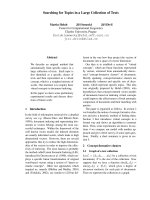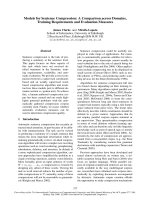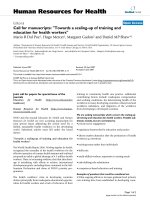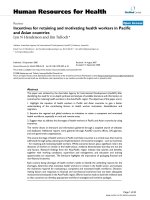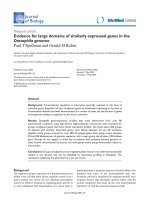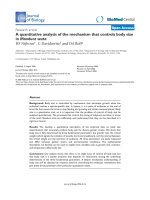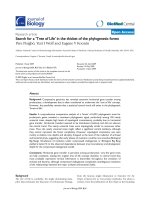Báo cáo sinh học: "Searching for phenotypic causal networks involving complex traits: an application to European quail" doc
Bạn đang xem bản rút gọn của tài liệu. Xem và tải ngay bản đầy đủ của tài liệu tại đây (3.28 MB, 35 trang )
This Provisional PDF corresponds to the article as it appeared upon acceptance. Fully formatted
PDF and full text (HTML) versions will be made available soon.
Searching for phenotypic causal networks involving complex traits: an
application to European quail
Genetics Selection Evolution 2011, 43:37 doi:10.1186/1297-9686-43-37
Bruno D Valente ()
Guilherme JM Rosa ()
Martinho A Silva ()
Rafael B Teixeira ()
Robledo A Torres ()
ISSN 1297-9686
Article type Research
Submission date 20 May 2011
Acceptance date 2 November 2011
Publication date 2 November 2011
Article URL />This peer-reviewed article was published immediately upon acceptance. It can be downloaded,
printed and distributed freely for any purposes (see copyright notice below).
Articles in Genetics Selection Evolution are listed in PubMed and archived at PubMed Central.
For information about publishing your research in Genetics Selection Evolution or any BioMed
Central journal, go to
/>For information about other BioMed Central publications go to
/>Genetics Selection Evolution
© 2011 Valente et al. ; licensee BioMed Central Ltd.
This is an open access article distributed under the terms of the Creative Commons Attribution License ( />which permits unrestricted use, distribution, and reproduction in any medium, provided the original work is properly cited.
1
Searching for phenotypic causal networks involving
complex traits: an application to European quail
Bruno D Valente
1,2§
, Guilherme JM Rosa
2,3
, Martinho A Silva
1
, Rafael B Teixeira
4
,
Robledo A Torres
4
1
Department of Animal Sciences, Federal University of Minas Gerais, 30123-970, Brazil
2
Department of Animal Sciences, University of Wisconsin, Madison, Wisconsin USA
53706
3
Department of Biostatistics and Medical Informatics, University of Wisconsin, Madison,
Wisconsin USA 53706
4
Department of Animal Sciences, Federal University of Viçosa, 36570-000, Brazil
§
Corresponding author
Email addresses:
BDV:
GJMR:
MAS:
RBT:
RAT:
2
Abstract
Background: Structural equation models (SEM) are used to model multiple traits and the
casual links among them. The number of different causal structures that can be used to fit
a SEM is typically very large, even when only a few traits are studied. In recent
applications of SEM in quantitative genetics mixed model settings, causal structures were
pre-selected based on prior beliefs alone. Alternatively, there are algorithms that search
for structures that are compatible with the joint distribution of the data. However, such a
search cannot be performed directly on the joint distribution of the phenotypes since
causal relationships are possibly masked by genetic covariances. In this context, the
application of the Inductive Causation (IC) algorithm to the joint distribution of
phenotypes conditional to unobservable genetic effects has been proposed.
Methods: Here, we applied this approach to five traits in European quail: birth weight
(BW), weight at 35 days of age (W35), age at first egg (AFE), average egg weight from
77 to 110 days of age (AEW), and number of eggs laid in the same period (NE). We have
focused the discussion on the challenges and difficulties resulting from applying this
method to field data. Statistical decisions regarding partial correlations were based on
different Highest Posterior Density (HPD) interval contents and models based on the
selected causal structures were compared using the Deviance Information Criterion
(DIC). In addition, we used temporal information to perform additional edge orienting,
overriding the algorithm output when necessary.
Results: As a result, the final causal structure consisted of two separated substructures:
BW→AEW and W35→AFE→NE, where an arrow represents a direct effect.
3
Comparison between a SEM with the selected structure and a Multiple Trait Animal
Model using DIC indicated that the SEM is more plausible.
Conclusions: Coupling prior knowledge with the output provided by the IC algorithm
allowed further learning regarding phenotypic causal structures when compared to
standard mixed effects SEM applications.
4
Background
Structural equation models or SEM ([1,2]) are used to model multiple traits and
functional links among them, which may be interpreted as causal relationships. These
models were adapted for the context of quantitative genetics mixed models by [3], and
henceforth applied and extended by a number of authors [4-11].
Fitting SEM requires choosing a causal structure a priori. This structure describes
qualitatively the causal relationships among traits by determining the subset of traits that
imposes causal influence on each phenotype studied. By fitting a SEM, it is possible then
to infer the magnitude of each causal relationship pertaining to the causal structure, which
is quantified by model parameters called structural coefficients. However, choosing the
causal structure may be cumbersome, given the typically very large space of possible
causal hypotheses, even when only a few traits are studied. The choice of causal
structures for the aforementioned SEM applications that followed the work of [3] were
performed on the basis of prior beliefs, resulting in poor exploration of structures spaces.
Methodologies such as the IC algorithm [12,13] make it possible to search for
recursive causal structures that are compatible with the joint probability distribution of
the variables considered. Therefore, applying these methodologies allows the selection of
causal structures without relying on prior knowledge alone. Nonetheless, such algorithms
are constructed based on specific assumptions regarding the data, such as the causal
sufficiency assumption (for more details, see [12,14]). Under this assumption, the
residuals of the SEM for which the causal structure will be chosen are regarded as
independent between traits. This construction is necessary to establish the connection
between the selected causal structures and the joint probability distribution under study,
5
such that d-separations [12,14] in causal structures among traits are reflected as null
partial correlations. Under this scenario, the IC algorithm takes a correlation matrix as
input and searches for causal structures that are capable of producing that matrix, with its
conditional dependencies and independencies. However, multiple phenotypes may
present unobserved correlated genetic effects which confound such search, as discussed
by Valente et al. [15]. When using mixed effects SEM to represent this scenario, this
confounding may take place even if model residuals are regarded as independent. As an
alternative, Valente et al. [15] proposed a methodology which couples Bayesian model
fitting and the application of the IC algorithm to the joint distribution of phenotypes
conditional on the genetic effects.
With the purpose of validating and illustrating their method, Valente et al. [15]
applied it to simulated data based on different scenarios. Here, we present the first
application of such methodology to a real data set, by exploring the space of causal
structures among five productive and reproductive traits in European quail. The
discussion is focused on the challenges and benefits resulting from applying this method
to field data, as well as on proposing approaches to overcome such challenges.
Methods
Data
The data refer to 849 female European quail (Coturnix coturnix coturnix) from six
distinguished hatch seasons. The birds were raised in an experimental station, with ad
libitum access to water and 2,900 kcal/kg and 28% crude protein diet. They were kept on
the floor until 35 days of age, and then transferred to individual cages, and provided a
6
laying diet henceforth. Five traits were analyzed: birth weight (BW), weight at 35 days of
age (W35), age at first egg (AFE), average egg weight from 77 to 110 days of age
(AEW), and number of eggs laid in the same period (NE). Measurements for all five
traits were available for every bird, with no missing data. Means and standard deviations
for each trait are presented in Table 1. Additionally, the analysis considered pedigree
information, containing 10,680 individuals.
Structural equation models
The SEM used to fit the data may be represented as ([3,15]):
(
)
= ⊗ + + +
Λ β
Λ βΛ β
Λ β
y I y X Zu e
n
, (1)
with the joint distribution of vectors u and e as:
0
0
~ ,
n
N
⊗
⊗
G A 0
u 0
0 I
e 0
Ψ
ΨΨ
Ψ
, (2)
where
y
,
u
and
e
are, respectively, vectors of phenotypic records, additive genetic
effects and model residuals for t traits, sorted by trait and subject within trait;
β
ββ
β
is a
vector containing the (fixed) effects of hatch season for each trait;
X
and
Z
are
incidence matrices relating effects in
β
ββ
β
and
u
to
y
;
Λ
ΛΛ
Λ
is a (t × t) matrix with zeroes on
the diagonal and with structural coefficients or zeroes on the off-diagonal (the causal
structure defines which entries contain free parameters and which entries are constrained
to 0);
0
G
and
0
Ψ
ΨΨ
Ψ
are the additive genetic and residual covariance matrices, respectively;
and A is the genetic relationship matrix, constructed from pedigree information. The
model given by (1) may be rewritten as:
(
)
− ⊗ = + +
Λ β
Λ βΛ β
Λ β
I I y X Zu e
tn n
, (3)
7
such that the so-called reduced model is expressed as:
( ) ( )
1 1
tn n tn n
− −
= − ⊗ + − ⊗ +
y I I X I I Zu
Λ β Λ
Λ β ΛΛ β Λ
Λ β Λ
( )
1
tn n
−
− ⊗
I I e
Λ
ΛΛ
Λ . (4)
Therefore,
( ) ( )
( )
{
1
0
| , , , ~ ,
tn n
p N
−
− ⊗ +
y u I I X Zu
Λ β Ψ Λ β
Λ β Ψ Λ βΛ β Ψ Λ β
Λ β Ψ Λ β
( ) ( )
}
1 1
I I I IΛ Ψ Λ
Λ Ψ ΛΛ Ψ Λ
Λ Ψ Λ
− −
′
− ⊗ − ⊗
tn n tn n
, (5)
where
0
I
Ψ Ψ
Ψ ΨΨ Ψ
Ψ Ψ
n
= ⊗
.
Recursive causal structure selection
Selection of causal structure was performed by following the methods presented by [15].
As mentioned by these authors, there are algorithms that search for recursive causal
structures (i.e. causal structures with no cycles or feedback relationships between traits)
assuming that conditional independencies in the joint probability distribution of the
studied variables mirror d-separations in the causal structure (for more details, see [12,
14-16]). One of such algorithms is the Inductive Causation (IC) algorithm, which is able
to search, within typically vast causal structure spaces, for a class of minimal structures
that are compatible with the conditional independencies carried by the joint distribution
of the data. This class consists of statistically equivalent causal structures that impose the
same set of stable conditional independencies in the joint distribution (i.e. they cannot be
distinguished on the basis of data evidence) and may be represented by a partially
oriented graph, i.e., a causal structure carrying directed and undirected edges, the latter
representing causal connections with unspecified causal direction. The edges that are left
8
undirected by the algorithm may present one direction or the other in different structures
within the class, such that no direction results in causal cycles or further unshielded
colliders (sub-structures consisting of unlinked vertices with a common child, such as
j
y
→
j
y
′′
←
j
y
′
, where j, j’, and j’’ are indexes indicating three different phenotypic
traits, and
j
y
→
j
y
′
indicates that
j
y
directly affects
j
y
′
). The IC algorithm, when
applied to a set P of t phenotypic traits, can be described as follows:
Step 1 . For each pair of phenotypic traits
j
y
and
j
y
′
(
)
1, 2, ,
j j t
′
≠ =
in P, search
for a set of traits
jj
′
S
such that
j
y
is independent of
j
y
′
given
jj
′
S
. If
j
y
and
j
y
′
are
dependent for every possible
jj
′
S
, connect
j
y
and
j
y
′
with an undirected edge. This step
returns an undirected graph U.
Step 2 . For each pair of non-adjacent traits
j
y
and
j
y
′
with a common adjacent trait
j
y
′′
in U (i.e.,
j
y
–
j
y
′′
–
j
y
′
), search for a set
jj
′
S
containing
j
y
′′
such that
j
y
is
independent of
j
y
′
conditional on
jj
′
S
. If there is no such set, then add arrowheads
pointing at
j
y
′′
(
j
y
→
j
y
′′
←
j
y
′
). Otherwise, continue.
Step 3 . In the partially oriented graph returned by the previous step, orient as
many undirected edges as possible in such a way that it does not result in new unshielded
colliders or in cycles.
An important point to observe regarding the study of causal structures among
phenotypic traits is that even if the residual covariance matrix is considered as diagonal,
which is a consequence of the causal sufficiency assumption, unobserved correlated
9
genetic effects act as sources of confounding ([15,16]). Such feature damages the
connection between causal structures and joint probabilities such that d-separations in the
former are not expected to be reflected as conditional independencies in the latter.
However, conditionally on the genetic effects, this connection is restored. Assessing this
conditional probability distribution is possible since such effects can be ‘controlled’
based on a genetic distance matrix (e.g. a genetic relationship matrix). The conditional
covariance matrix of y given u can be obtained by fitting a standard multiple trait animal
model (MTAM, [17]) and obtaining the estimated residual covariance matrix, here
represented by
*
0
R
. In some systems, other factors (e.g. correlated maternal effects) may
also impose confounding in the search, and in these cases they should also be
incorporated in the MTAM from which
*
0
R
will be taken as the algorithm’s input. Using
Bayesian data analysis with a Markov chain Monte Carlo (MCMC) implementation, the
following approach was proposed by [15]:
Step 1. Fit a MTAM and draw samples from the posterior distribution of
*
0
R
.
Step 2. Apply the IC algorithm to the posterior samples of
*
0
R
to make the
statistical decisions required. Specifically, for each query about the statistical
independence between phenotypes
j
y
and
j
y
′
(
)
1, 2, ,
j j t
′
≠ =
given a set of traits S
and, implicitly, the genetic effects:
a) Obtain the posterior distribution of residual partial correlation
, |
j j
′
ρ
S
. These
partial correlations are functions of
*
0
R
. Therefore, samples from their posterior
10
distribution can be obtained by computing the correlation at each sample drawn
from the posterior distribution of
*
0
R
.
b) Compute the highest posterior density (HPD) interval with some specified
probability content for
, |
j j
′
ρ
S
.
c) If the HPD interval contains 0, declare
, |
j j
′
ρ
S
as null. Otherwise, declare
j
y
and
j
y
′
as conditionally dependent.
Step 3. Fit a SEM using the selected causal structure (or one member within the
class of statistically equivalent structures returned by the IC algorithm) as the ‘true’
causal structure.
More details on causal structure search based on observational data are given by
[12, 14]. Additionally, the approach proposed to select recursive causal structures in the
quantitative genetics mixed model context is discussed by [15] and reviewed in [16].
Application of the IC algorithm involves performing a set of statistical decisions
about declaring partial correlations as null or not. As the posterior distribution of these
parameters becomes flatter, the statistical decisions get poorer, i.e. errors become more
likely. In this scenario, using a high content HPD interval (such as 95%) protects against
declaring a null correlation as non-null, but the algorithm becomes more prone to
declaring non-null correlations as null. However, these two types of errors are equally
important when exploring causal structure spaces [18], and therefore, in scenarios where
posterior distributions of partial correlations are not sharp, results may be better when
decisions are made on the basis of HPD intervals with lower content. In this article we
applied several HPD content magnitudes (70, 75, 80, 85, 90, and 95%), and compared the
final causal structures obtained. This approach may indicate the edges and the structures
11
that are more stable to changes in the magnitude of HPD contents used for the statistical
decisions.
Bayesian inference and fully recursive model
The models studied were fitted via Bayesian analysis and consisted of SEM with
recursive causal structures and a diagonal residual covariance matrix, as described in
[15]. A fully recursive model is represented by a SEM where every entry below the
diagonal of
Λ
ΛΛ
Λ
is treated as a free parameter. The likelihood equivalence between MTAM
and SEM with fully recursive causal structures ([9]) was explored to make inferences
about the parameters of the former model by fitting the latter. The residual covariance
matrix of an MTAM, which is needed for the recursive causal structure search, was
obtained by fitting a fully recursive SEM and then transforming its residual covariance
matrix by:
( ) ( )
1 1
*
0 fr fr fr
− −
′
= − −R I IΛ Ψ Λ
Λ Ψ ΛΛ Ψ Λ
Λ Ψ Λ ,
where
fr
Λ
ΛΛ
Λ
and
fr
Ψ
ΨΨ
Ψ
are, respectively, a matrix of structural coefficients and a diagonal
residual covariance matrix, both associated with a fully recursive model. Such approach
allowed all the models studied in this article to be fitted by using the same program.
The following joint prior distribution was assumed for location and dispersion
parameters of model (1):
( )
( ) ( )
( ) ( )
( )
0 0 0 0
1
, , , , |
=
=
∏
Λ β Ψ Λ β
Λ β Ψ Λ βΛ β Ψ Λ β
Λ β Ψ Λ βu G u G G
ψ
t
j
j
p p p p p p
0 0 0
( | 0, ) ( | , )
N IW
υ
•
∝ ⊗ × ×
G
u G A G G
12
2 2
1
- ( | , )
t
j
j
Inv s
ψ
χ ψ υ
=
∏
,
where
0
( | , )
N ⊗
u 0 G A
is a multivariate normal density centered at 0 and covariance
matrix
0
⊗
G A
,
0 0
( | , )
•
G
G G
υ
IW
is an Inverse Wishart density with
G
υ
degrees of
freedom and scale matrix
0
•
G
,
2 2
- ( | , )
ψ
χ ψ υ
j
Inv s
is a scaled inverse-chi-square
distribution with
ψ
υ
degrees of freedom and scale parameter
2
s
, and
j
ψ
is the residual
variance for trait j. Unbounded uniform distributions were assigned as prior distributions
for
β
ββ
β
and for each structural coefficient in
Λ
ΛΛ
Λ
. Furthermore,
G
υ
,
0
G
•
,
ψ
υ
and
2
s
were
regarded as known hyperparameters of the prior distribution. The following
hyperparameter values were used for all SEM considered:
35
2 2
0.6, 400,
BW W
s s= =
2 2 2
70, 0.7, 40
AFE AEW NE
s s s
= = =
and
3
Ψ
υ
=
for every entry of the diagonal of
Ψ
ΨΨ
Ψ
;
7
G
=
υ
and
0
0.3 0 0 0 0
0 200 0 0 0
.
0 0 30 0 0
0 0 0 0.3 0
0 0 0 0 10
•
=
G
The analyses were carried out using programs written in R ([19]), which are
available from the authors upon request. As all fully conditional posterior distributions
had closed forms, a Gibbs sampler, as discussed in [15], was applied to obtain a single
chain of 300,000 iterations for each model fitted. On the basis of visual inspection of a
subset of parameters, including the structural coefficients, genetic and residual
covariances, the initial 100,000 samples of each chain were discarded as a conservative
13
burn-in. The remaining 200,000 iterations were regarded as samples from the posterior
distributions of the parameters. The retained samples were used as basis for recursive
causal structure search via IC algorithm, model comparison, and inferences about the
parameters of the model fitted conditionally on the selected causal structure.
Model comparison
Causal structures within a class of observationally equivalent structures cannot be
distinguished on the basis of data evidence because they result in the same set of
probabilistic conditional independencies. Therefore, they cannot be compared using
criteria that rely on the likelihood function. However, structures from distinguished
classes are expected to induce distinct features on the joint distribution, such that they
may be compared using data evidence. In the present article, we used the Deviance
Information Criterion (DIC, [20]) to compare models that present causal structures
pertaining to distinct classes of structures. Such approach is followed here because
different classes of causal structures may emerge from applying the search methodology
using different HPD interval contents for statistical decisions. The same criterion was
used to check the quality of fit of the SEM conditional on the selected causal structures
by comparing them with a standard MTAM, which carries no restrictions on the
dispersion parameters. Considering
θ
as a vector containing the model parameters, and
(
)
(
)
(
)
2 log |
D p= −
θ y θ
, which is called the deviance function, the DIC was obtained as
follows:
(
)
2DIC D D= −
θ
,
14
where
θ
, which is the posterior mean of
θ
, and
(
)
|
D E D=
θ y
θ
were obtained from the
posterior samples of
θ
.
Results and discussion
Fitting the fully recursive SEM resulted in posterior means and 95% HPD intervals of
each
*
0
R
and
*
0
G
entry as given in Table 2. These matrices represent residual and
additive genetic covariance matrices pertaining to a MTAM, respectively. The posterior
distributions of the heritabilities as obtained from the same model are presented in Figure
1. It shows that the analyzed traits present moderate to high heritabilities, with posterior
means ranging from 0.151 (NE) to 0.591 (BW).
After applying the described approach for causal structure search based on
different HPD interval contents, the three undirected graphs depicted in Figure 2 were
selected. The output was completely undirected for each search performed because no
evidence of unshielded colliders was detected. It should be stressed that finding
unshielded colliders is essential for edge orienting by the IC algorithm.
As already stated, the undirected or semidirected graphs returned by the IC
algorithm represent classes of equivalent causal structures. However, the undirected
graph returned when using a 70% HPD interval for the statistical decisions (Figure 2a)
implies a set of observational consequences that, given the algorithm assumptions, cannot
result from a SEM with recursive causal structure and independent residuals.
Specifically, any attempt to direct the edges of the graph inevitably results in a causal
cycle, or in unshielded colliders. Causal cycles belong to structures that are outside the
explored space, and adding unshielded colliders diverges from the algorithm’s output,
15
which indicated that no evidence of such sub-structures was found from the partial
correlations studied in the second step. These types of results indicate that some
assumption(s) of the model or of the IC algorithm may not hold. As suggested by
[12,14,18], one may combine the IC algorithm framework with prior knowledge to select
causal structures. Here we choose to consider the structure in Figure 2a as a ‘skeleton’
and orient its edges according to temporal information. The temporal sequence followed
by the phenotypic traits is: (1) BW, (2) W35, (3) AFE and (4) AEW and NE. This
information prompted us to propose a causal structure as in Figure 3a, which presents two
unshielded colliders that were not detected in the initial search, but carries all the edges
that were previously detected.
Given the HPD contents applied to the IC algorithm, the output in Figure 2b may
be considered as the most stable, since it was consistently selected when using HPD
intervals of 75%, 80%, 85% and 90%. This structure is similar to the one obtained using
70% HPD intervals, except for the absence of the edge connecting BW and NE. Another
difference from the previous selected structure is that this slightly sparser undirected
graph reflects a set of conditional independencies that could effectively result from a
recursive SEM. In other words, this undirected graph represents a non-empty class of
recursive causal structures, which is in contrast to the graph previously discussed, which
suggested features in the joint distribution that could not result from an acyclic SEM
under the causal sufficiency assumption. However, every instance of this class conflicts
with the prior knowledge regarding the temporal sequence of the studied traits, i.e. every
structure of this class considers that at least one trait is affected by some other trait not
yet expressed. More specifically, for every member of this causal structure class, AEW is
16
regarded as a cause of W35, or a cause of BW, or both. Here we allowed the temporal
sequence information to override the algorithm output, leading to the oriented structure
presented in Figure 3b, which involves adding in the unshielded collider BW → AEW ←
W35.
Finally, the last selected structure resulted from using the proposed approach
based on 95% HPD intervals to make the statistical decisions. As presented in Figure 2c,
this structure is also undirected, and consists of two disconnected sub-structures. Unlike
the previous outputs, this class of structures carries one structure that is consistent with
the temporal information regarding the studied traits, which is depicted in Figure 3c.
Moreover, the edges conveyed by this undirected graph were the most stable, as they
were present for every HPD interval content that was used in the search methodology.
Three distinguished SEM were constructed conditionally on the causal structures
presented in Figure 3a (model A), 3b (model B) and 3c (model C). DIC`s obtained for
each of these models are presented in Table 3. This criterion indicated that model C,
which is the simplest among these models, should be preferred. Models that present extra
edges are typically expected to present a better fit. However, DIC may not assign better
scores to such complex models if the extra goodness of fit achieved is not sufficient to
compensate for the penalty given for model flexibility (number of parameters).
Furthermore, it should be observed that models A and B carry unshielded colliders that
are not supported by data evidence, i.e. the statistical consequences of their presence in
the causal structure were not found when the posterior distribution of
*
0
R
was used as
input for the IC algorithm. This may have resulted in extra penalty in the DIC of these
models due to decreased goodness of fit, which is suggested by their larger DIC when
17
compared to the MTAM. On the other hand, the smaller DIC of model C when compared
to MTAM’s indicates that this structure is indeed plausible, presenting a good fit despite
having the strongest constraints among the models studied.
Inferences about the dispersion parameters of a SEM that carries the selected
structure (model C), as well as its structural coefficients, are presented in Table 4 and
Figure 4, respectively. According to the causal structure selected and the parameter
inferences, W35 imposes a negative causal effect over AFE. The posterior distribution of
the magnitude of the change in AFE due to a 1g increase in W35 is given in Figure 4a,
with a posterior mean of -0.052 day/g. In turn, AFE also imposes a negative effect on NE,
with a posterior mean of -0.113 egg/day and the posterior distribution depicted in Figure
4c. This structure also implies that W35 presents an indirect positive causal effect on NE.
Finally, inferences concerning the remaining edge indicate that BW has a negative causal
effect on AEW, for which the posterior distribution is depicted in Figure 4b, with
posterior mean of -0.408 g/g. At first sight, this result may seem unexpected given that
phenotypes for these traits present positive covariance. However, according to the
inferences for MTAM dispersion parameters, this positive phenotypic association is due
to a strong positive additive genetic association (genetic covariance with posterior mean
of 0.30 g
2
). Conditional on the genetic effects, the association between these traits
becomes negative, as represented by residual covariance with a posterior mean of -0.12
g
2
. As a consequence, the causal association between BW and AEW could only be
negative given that the causal association between BW and AEW is disconnected from
the remainder of the causal structure, and given that causal sufficiency is assumed in the
causal structure search.
18
The reduction of a SEM transforms model parameters in parameters of a MTAM.
Inferences about heritabilities, residual and genetic covariances from a reduced model
based on model C are shown in Figure 5 and Table 5. These posterior distributions are
quite similar to the posterior distributions obtained for MTAM for the same parameters
(Figure 1 and Table 2). This similarity was expected given that the IC algorithm searches
for causal structures that are minimal and yet compatible with the distribution of the data
(which is in principle described without constraints by a MTAM) and that using the
chosen structure resulted in good fit according to the comparison between model C and
MTAM via DIC. An opposite scenario with strong disagreements between inferences
obtained under both models would indicate that features of the selected causal structure
are not coherent with data evidence. This conflict would denote that the selected causal
structure is not plausible.
It should be stressed that one’s interpretation of the output provided by the
approach proposed by [15] must be guided by the (causal) assumptions one is willing to
accept. This methodology could be regarded as causal structure inference in situations
where the assumptions provided by [14] are accepted (namely: (1) causal sufficiency, (2)
same causal relations for every individual in population, (3) faithfulness of joint
distribution to an acyclic directed graph, and (4) correctness of statistical decisions).
Some causal learning may still take place even if we do not accept the strong assumption
of causal sufficiency (i.e., that every variable which affects two or more variables under
study is already in the set of the studied variables). Applying this to the results of the
present study, the existence of causal influence of AFE over NE could be claimed by
simply accepting the Causal Markov Condition (which is not an assumption as strong as
19
causal sufficiency) and by acknowledging temporal information (W35 before AFE, and
the latter before NE) ([21]). Nevertheless, structural equation modeling may be used
without learning from the causal information carried by it. Under this circumstance, the
goal may simply be to represent a joint probability distribution in a more parsimonious
fashion. Generally, when a recursive causal structure is applied with this purpose, the
residual covariance matrix is constructed as diagonal to achieve parameter identifiability.
Nonetheless, this is exactly the statistical consequence of accepting the IC algorithm’s
causal sufficiency assumption, so that the described methodology may be properly used
under this construction. Because the proposed approach searches for minimal causal
structures, applying the retrieved structures to fit a recursive SEM would result in
parsimonious modeling of joint probability distributions derived from multiple trait
models.
Competing interests
The authors declare that they have no competing interests.
Authors' contributions
BDV, GJMR, and MAS conceived the study. MAS, RAT, and RBT were responsible for
data collection and provided critical insights. BDV carried out the analysis.
BDV and GJMR wrote the manuscript. All authors read and approved the
final manuscript.
20
Acknowledgements
BDV, MAS, RBT and RAT acknowledge support from Conselho Nacional de
Desenvolvimento Científico e Tecnológico and Coordenação de Aperfeiçoamento de
Pessoal de Nível Superior, Brazil. GJMR would like to acknowledge support from the
Vilas Associate Award, Graduate School of University of Wisconsin, and Agriculture
and Food Research Initiative Competitive Grant no. 2011-67015-30219 from the USDA
National Institute of Food and Agriculture.
References
1. Haavelmo T: The statistical implications of a system of simultaneous
equations. Econometrica 1943, 11:12.
2. Wright S: Correlation and causation. J Agric Res 1921, 201:557–585.
3. Gianola D, Sorensen D: Quantitative genetic models for describing
simultaneous and recursive relationships between phenotypes. Genetics 2004,
167:1407-1424.
4. de los Campos G, Gianola D, Boettcher P, Moroni P: A structural equation
model for describing relationships between somatic cell score and milk yield
in dairy goats. J Anim Sci 2006, 84:2934-2941.
5. de los Campos G, Gianola D, Heringstad B: A structural equation model for
describing relationships between somatic cell score and milk yield in first-
lactation dairy cows. J Dairy Sci 2006, 89:4445-4455.
21
6. Heringstad B, Wu XL, Gianola D: Inferring relationships between health and
fertility in Norwegian Red cows using recursive models. J Dairy Sci 2009,
92:1778-1784.
7. de Maturana EL, Campos Gdl, Wu XL, Gianola D, Weigel KA, Rosa GJM:
Modeling relationships between calving traits: a comparison between
standard and recursive mixed models. Genet Sel Evol 2010, 42:1.
8. de Maturana EL, Wu XL, Gianola D, Weigel KA, Rosa GJM: Exploring
biological relationships between calving traits in primiparous cattle with a
Bayesian recursive model. Genetics 2009, 181:277-287.
9. Varona L, Sorensen D, Thompson R: Analysis of litter size and average litter
weight in pigs using a recursive model. Genetics 2007, 177:1791-1799.
10. Wu XL, Heringstad B, Chang YM, de los Campos G, Gianola D: Inferring
relationships between somatic cell score and milk yield using simultaneous
and recursive models. J Dairy Sci 2007, 90:3508-3521.
11. Wu XL, Heringstad B, Gianola D: Exploration of lagged relationships between
mastitis and milk yield in dairy cows using a Bayesian structural equation
Gaussian-threshold model. Genet Sel Evol 2008, 40:333-357.
12. Pearl J: Causality: Models, Reasoning and Inference. Cambridge, UK: Cambridge
University Press; 2000.
13. Verma T, Pearl J: Equivalence and synthesis of causal models. In Proceedings
of the 6th Conference on Uncertainty in Artificial Intelligence, 27-29 July1990
Cambridge, Edited by Henrion M, Shachter R, Kanal L, Lemmer J; 1990:220-
227.
22
14. Spirtes P, Glymour C, Scheines R: Causation, Prediction and Search. 2 edn.
Cambridge, MA: MIT Press; 2000.
15. Valente BD, Rosa GJM, de los Campos G, Gianola D, Silva MA: Searching for
recursive causal structures in multivariate quantitative genetics mixed
models. Genetics 2010, 185:633-U361.
16. Rosa GJM, Valente BD, Campos Gdl, Wu XL, Gianola D, Silva MA: Inferring
causal phenotype networks using structural equation models. Genet Sel Evol
2011, 43:6.
17. Henderson CR, Quaas RL: Multiple trait evaluation using relative records. J
Anim Sci 1976, 43:1188-1197.
18. Shipley B: Cause and Correlation in Biology. Cambridge/London/New York:
Cambridge University Press; 2002.
19. R Development Core Team: R: A Language and Environment for Statistical
Computing. R Foundation for Statistical Computing: 2009.
20. Spiegelhalter DJ, Best NG, Carlin BR, van der Linde A: Bayesian measures of
model complexity and fit. J R Stat Soc Ser B-Stat Methodol 2002, 64:583-616.
21. Scheines R: An introduction to causal inference. In Causality in crisis. Citeseer;
1997:185-199.
23
Figure 1 - Posterior density of MTAM heritabilities
BW = birth weight, W35 = weight at 35 days, AFE = age at first egg, AEW = average
egg weight from 77 to 110 days, and NE = number of eggs produced from 77 to 110 days
Figure 2 - Graphs returned by the IC algorithm using HPD 70% (a), 75, 80, 85 and
90% (b), and 95% (c) for the statistical decisions involving the traits considered
BW = birth weight, W35 = weight at 35 days, AFE = age at first egg, AEW = average
egg weight from 77 to 110 days, and NE = number of eggs produced from 77 to 110 days
Figure 3 - Graphs selected by combining prior temporal information with the
output of the IC algorithm using HPD 70% (a), 75, 80, 85 and 90% (b), and 95% (c)
for the statistical decisions involving the traits considered
BW = birth weight, W35 = weight at 35 days, AFE = age at first egg, AEW = average
egg weight from 77 to 110 days, and NE = number of eggs produced from 77 to 110 days
Figure 4 - Posterior densities of structural coefficients pertaining to Model C
24
Figure 5 - Posterior density of heritabilities pertaining to a reduced SEM with
causal structure C
BW = birth weight, W35 = weight at 35 days, AFE = age at first egg, AEW = average
egg weight from 77 to 110 days, and NE = number of eggs produced from 77 to 110 days
